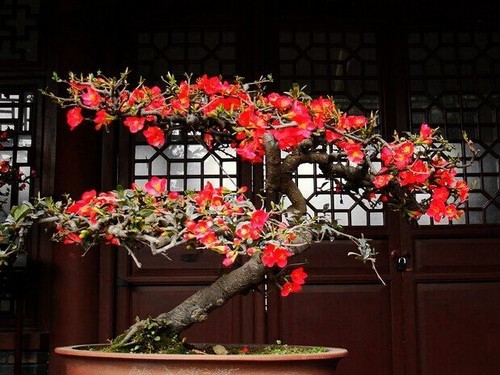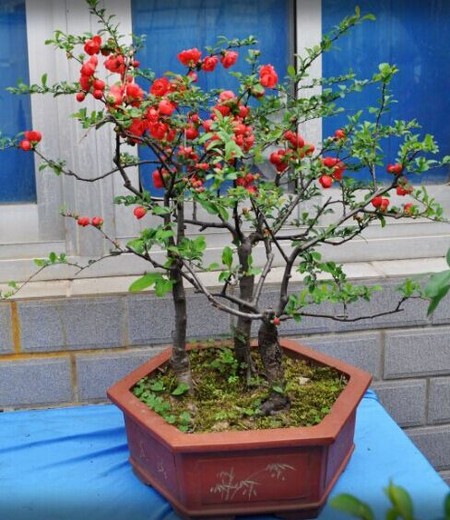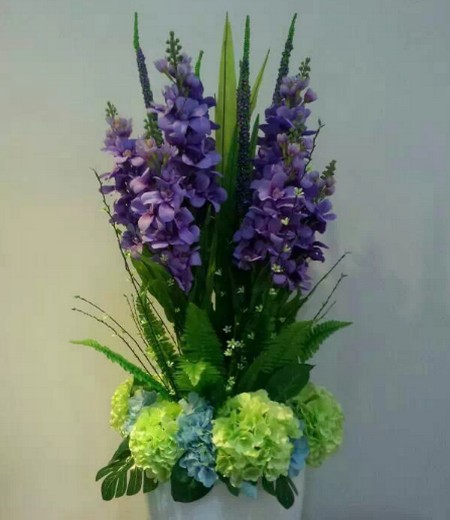Maintenance method of potted landscape of begonia with stick stem
Tripterygium originated in western and southern China, is a positive flowers and trees, simple leaves alternate, leaves oval or long oval, edge with sharp teeth; flowering period is longer, usually from March to May, flowers are slightly earlier than leaves or flowers and leaves, 3 to 5 flowers are clustered; fruit can be produced in autumn. Pedicel begonia can be planted in the ground or in the pot. Early spring leaves bloom, the color is red and pleasing to the eye, is a good ornamental period. Yellow pear fruit in autumn, fragrant smell, but also quite ornamental value. If the pedicel crabapple is put into the greenhouse after autumn, it can blossom in advance in the Spring Festival.

Because the pedicel crabapple is not only beautiful and pleasing to the eye, but also the branches are vigorous and oblique, hard and powerful, it can also be made into bonsai for viewing flowers and fruits, which is just soft and full of ancient meaning, and has high ornamental value. The following is to introduce its maintenance methods:
1. Place of placement:
Paste stem begonia bonsai should be placed in a place with sufficient light and air circulation. When it is hot in summer, it is necessary to take proper shade to prevent the leaves from burning. Winter can be more cold-resistant, can be buried in the soil, can also be put into the indoor window.
2. Watering:
Usually keep the basin soil moist, but we must pay attention to prevent stagnant water in the basin, otherwise the root is easy to rot. The potted soil should not be too dry during the growing period of spring and summer, especially during flowering.
3. Fertilization:
It is appropriate to apply sufficient base fertilizer in winter, with dry cake fertilizer or rotten barnyard manure and bone meal. During the growth period, thin fertilizer and water are often applied except for the rainy season.
4. Pruning:
Most of them are carried out after flowering, and the branches that have flowered are generally cut short to promote the formation of branches and flower buds and increase the number of flowers in the coming year. At the same time, the beautiful branches such as overgrown branches, cross branches and overlapping branches should also be cut off in time. The dormant period after defoliation can be reshaped and pruned to remove withered and senescent branches to maintain a certain tree shape.
5. Turn the basin:
It should be carried out every 2-3 years, so that it can be carried out after flowering in spring or in autumn. When turning the basin, the root system should be trimmed and the base fertilizer should be put at the bottom of the basin.
6. Pest control:
Sticking Begonia often has rust on its leaves, which can be sprayed with Baume 0. 5-degree stone-sulfur mixture for prevention and control. The main insect pests are aphids, spider moths, red spiders and so on. The method of prevention and control is the same as that of Begonia.
Tripterygium is a common variety in the family of begonia. Sticking pedicel begonia is also called iron-footed begonia and sticking papaya, because the pedicel is very short, and the flower seems to be attached to the branches when it blossoms. The flowers and colors of Tripterygium are scarlet, pink, white and so on. When they bloom, they are bright, colorful and lovely.
[notes]
1. Sufficient water:
In the growth period of begonia should be given sufficient water, especially when the summer temperature is high, the basin soil is easy to dry, watering should be adequate. It should be noted that Tripterygium has a certain ability to resist drought, but it is very afraid of waterlogging, so we must avoid stagnant water in the basin soil, otherwise it will make the leaves yellow and even the plants die.
2. Pruning should be strengthened:
Pruning and shaping should be carried out after falling leaves in autumn or before sprouting in spring, cutting off dead branches, overgrown branches, cross branches, overlapping branches and other branches that affect the shape of the tree, so as to concentrate its nutrition, reduce consumption, and facilitate ventilation and light penetration. Cut off the top of the old branch that has flowered every other year, leaving only 20 or 30 centimeters at the base of the branch, which can promote branching and increase flowering branches. Potted plants should not hang more fruit, fruit should be thinned in time after flowering, and the position of retaining fruit should be in the key position of branch modeling, in order to balance the tree potential and highlight the key points. Although the fruit no longer grows after ripening, it also consumes nutrients and should be removed. For some double flower-watching varieties, the residual flowers can be removed after flowering to prevent them from bearing fruit, so as to facilitate the restoration of tree potential.
3. Change the basin every spring
The basin soil is required to be loose and fertile, rich in humus, sandy soil with good drainage and ventilation, and put some rotten cake fertilizer, animal hoof nail, bone and so on at the bottom of the basin as base fertilizer to support plant growth and flowering. When the fruit gradually expands in June and July, the amount of phosphorus and potassium fertilizer should be increased, and 0.2% potassium dihydrogen phosphate solution can be sprayed to the leaf to meet the needs of fruit development.
Time: 2019-06-01 Click:
- Prev

Culture method of bonsai of crabapple with stem
Begonia is a potted plant with great ornamental value, and many people have a special liking for Begonia. Pedicel Begonia flower color is more, the petals are clean and translucent, it is very beautiful, suitable for making bonsai to beautify the home, has its own unique flavor, very popular with people
- Next

Cultivation methods and precautions of delphinium
Delphinium can also be called dove flower, chicken claw lotus, thousand bird flower, stemona grass, etc., named because of its similar flower type and swallow, belonging to Delphinium of Ranunculaceae, which first grew in southern Europe. Now it is planted all over China, and it is common in grassland and hillside. Delphinium grows in bloom when a flock of blue birds falls from the sky
Related
- Fuxing push coffee new agricultural production and marketing class: lack of small-scale processing plants
- Jujube rice field leisure farm deep ploughing Yilan for five years to create a space for organic food and play
- Nongyu Farm-A trial of organic papaya for brave women with advanced technology
- Four points for attention in the prevention and control of diseases and insect pests of edible fungi
- How to add nutrient solution to Edible Fungi
- Is there any good way to control edible fungus mites?
- Open Inoculation Technology of Edible Fungi
- Is there any clever way to use fertilizer for edible fungus in winter?
- What agents are used to kill the pathogens of edible fungi in the mushroom shed?
- Rapid drying of Edible Fungi

